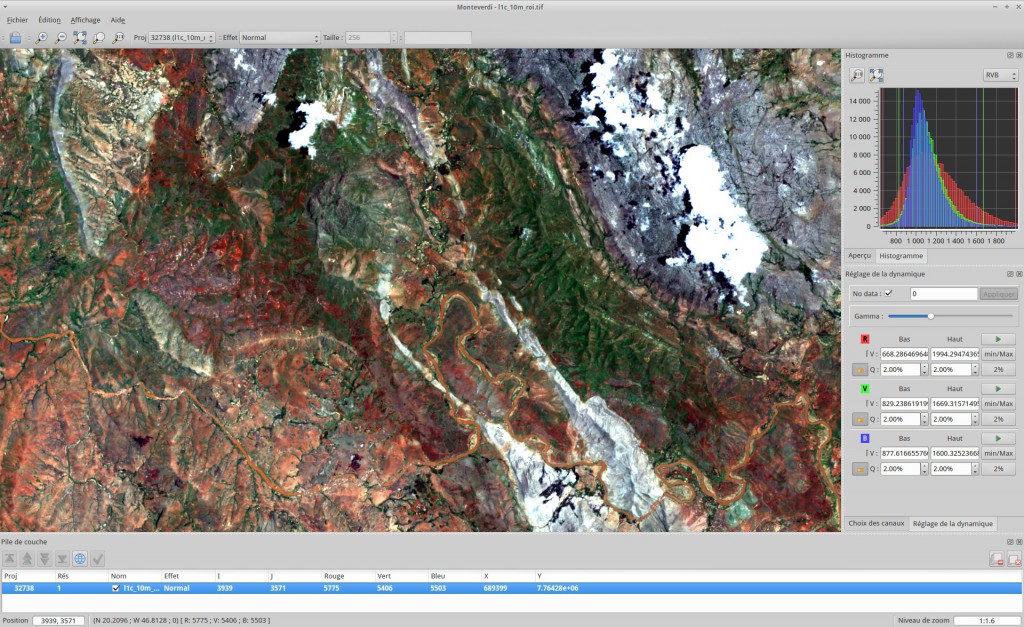We are very pleased to announce the release of Orfeo ToolBox 5.2 and Monteverdi 3.0, codename Mabuyinae. Orfeo ToolBox 4.0 brought compatibility with ITK 4.x series, and Orfeo ToolBox 5.0, brought modularity as well as a huge clean-up (third-party policy, deprecated code, superbuild …). This new 5.2 is all about new features :
- Support for read and write of no-data flags read by Gdal,
- New applications for SAR processing (polarimetry),
- Basic support of Sentinel1 products*,
- Radiometric calibration of Sentinel1 and Radarsat2,
- New methods for SAR Despeckle filtering (Frost, Lee, GammaMAP, Kuan)
- Regression mode in machine learning classes and applications,
- Confidence maps for classification filters and applications (including enhanced random forests confidence map),
- Enhanced syntax of applications python API,
- Support for default output types in applications,
- Compatibilty with Gdal 2.0 (as well as Gdal 1.10.x) and support of Sentinel-2
Release 5.2 was also the opportunity to improve the documentation with an up-to-date version of the Installation and compilation procedures in the Software Guide and also a new chapter in the CookBook with an Introduction to the new version of Monteverdi.
* OTB 5.2 is compatible with OSSIM svn revision 23537 , which include support for Sentinel-1. There is besides a known issue in OTB with OSSIM version superior to 23537 related to RPC sensor model support. Note that OSSIM has recently submit a patch to current development branch to fix this issue and release a new stable and compatible version (1.8.20-3) that can also be used with OTB 5.2.
Open governance: it’s working!
Orfeo ToolBox 5.2 is the first release that has been prepared under a fully open governance, and we can already feel the difference: work by all interested parties are publicly proposed, discussed and voted by the Project Steering Committee, which now counts 5 members. For this release, 19 Requests for Changes have been discussed, and 17 have been adopted. You can learn more about how the open governance of Orfeo ToolBox works by reading this wiki page.
Remote modules contributions
One of the new features of Orfeo ToolBox 5.0 was the ability for users to develop and propose remote modules, that can be downloaded and built along with Orfeo ToolBox. We are very happy to see that this new mechanism (inspired from ITK) allowed for five contributions already, two which became official remote module that you can select at configuration time:
- Generic Region Merging Segmentation (by Pierre Lassalle): provide the GRM OTB application to perform multi-scale region-merging segmentation on satellite images. Three local homogeneity criteria are available: the Baatz & Schäpe criterion, the Full Lambda Schedule criterion and the simple Euclidean Distance criterion.
- Images mosaicking (by Remi Cresson): one application dedicated to images mosaicking with several compositing methods available (radiometric/color harmonization, feathering).
- Object oriented image analysis (by Arnaud Durand): one application dedicated to merge the result of a segmentation with a pixel-based image classification in order to produce an object-oriented image classification and an other to compute radiometric and shape attributes on a vector dataset based on a support image.
If you are using Orfeo ToolBox and want to share your code with other, please do so, it is easy.
Goodbye Monteverdi2, welcome Monteverdi 3.0
As decided during the Orfeo ToolBox hackfest held in June 2015, we clarified the status of Monteverdi : we dropped completely Monteverdi 1.x, and also dropped the name Monteverdi2 (which was confusing). The graphical software based on Orfeo ToolBox is therefore called Monteverdi, and the new version is 3.0.
Why a major version number ? Because Monteverdi 3.0 offers many major changes with respect to Monteverdi2. We dropped the idea of a software with a persistent database of images (which was complex to maintain and difficult to use), and implemented instead a light stack-layer model. In Monteverdi 3.0, it is therefore possible to display several images together, as a stack or as a mosaic, and to use all the nice rendering tools of Ice. Applications are of course still available. We also cleaned the Cookbook for non-developers and wrote a nice introduction on how to use Monteverdi 3.0.
Sentinel2 in Orfeo ToolBox
With the opening of the Sentinel2 datahub, some of you asked us if the support of Sentinel2 products was part of the Orfeo ToolBox roadmap. It is indeed, but luckily for us, CNES took the action to fund a Sentinel2 Gdal driver, which is already available in Gdal trunk source code and documentation. The driver provides out-of-the-box support for L1B and L1C products, as well as support for L2A products generated with the sen2cor tool of the S1 ToolBox. You can therefore already have Sentinel2 support in Orfeo ToolBox, provided that your build uses the Gdal trunk version. We will try our best so that binary packages we are responsible for upgrade quickly or backport the driver in Gdal packaging. We already did it for Orfeo ToolBox Superbuild: you will be able to read Sentinel2 data using it.
Get it now!
Note that we dropped our Sourceforge page, so new version of Orfeo ToolBox (include 5.2) will not be available here anymore. Source and some binary packages can be downloaded from Orfeo ToolBox website or directly from the git repository. Packages for other distributions (Linux distributions, macports, osgeo4w) are in preparation and summarized and regularly updated on this wiki page.
We welcome your feedback and request, and encourage you to join the OTB community and mailing list.
OTB Dev Team
